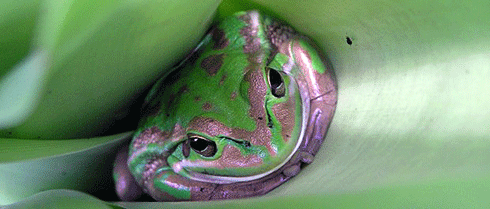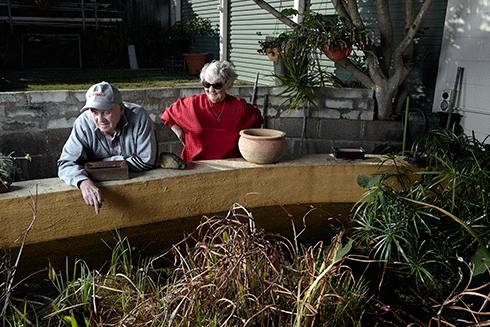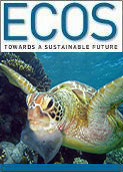
|
Published: 19 August 2013
Backyard a good place to start saving vulnerable species
A Sydney family has shown that biodiversity conservation can begin at home, after converting its backyard swimming pool into wetland habitat to save a colony of rare frogs.

|
|
The green and golden bell frog: finding a foothold in suburbia. Credit:
City of Sydney
|
Rosebery grandmother Elaine Davies turned wildlife protector when a colony of green and golden bell frogs – listed as ‘vulnerable’ under the Environment Protection and Biodiversity Conservation Act – migrated from sand dunes at a nearby industrial site into her disused, above-ground swimming pool.
When her children grew up, Mrs Davies says the pool was abandoned, then ‘without any help from us [the frogs] just migrated up to our pool. As far as they were concerned it was heaven!’
Mrs Davies turned her pool into a pond about ten years ago and since then it has been home to 30 to 40 frogs each season. Their numbers have declined in the past two years.
The discovery of the endangered frogs delighted ecologists who have fought to protect them at scattered habitats, such as the Sydney’s Olympic Park brick pits site.

|
|
The Davies and their backyard frog refuge. Credit:
City of Sydney
|
The City of Sydney’s new Urban Ecology Strategic Action Plan sets out practical steps for people like Elaine to follow in helping conserve biodiversity within the city’s weed-infested railway easements, footpaths and school yards where many native species cling for survival.
The municipal body released its first blueprint for saving local plant and animal species after an extensive urban ecology survey last year, when bandicoots, powerful owls, falcons and red bellied black snakes were spotted in urban areas.
The plan identifies 63 native birds, eight mammals, 11 reptiles and five frog species living in the City of Sydney. Among them, the green and golden bell frog, the powerful owl, the grey-headed flying fox, and the long-nosed bandicoot are threatened species that still call Sydney home.
To fight the pressure of urban development, predators and disease, the City wants to expand bush restoration and ensure that ecology is properly considered in development assessments. It also plans to run workshops about how to create habitats in backyards, balconies, footpaths and schools.
Other wildlife success stories detailed in the plan include restoration work by volunteers on Arthur (Paddy) Grey Reserve in Glebe, which has made the tiny park part of an important wildlife corridor and a new home to the endangered superb fairy-wren.
In Forest Lodge, a terrace house backyard now combines rainforest and undergrowth, attracting reptiles, frogs, rare bees and migrating birds.
The City is already creating habitats for small birds in pocket parks in Glebe and in Blackwattle Bay Park while at Sydney Park in St Peters, wetlands that support birds, frogs and reptiles were incorporated into the stormwater harvesting works.
The City of Sydney will hold a community information session about the strategy on 24 August at the Maiden Theatre, Royal Botanic Garden.
Source: City of Sydney



